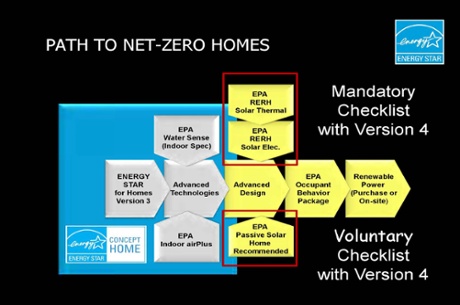If You Think ENERGY STAR Version 3 Is Hard…

Version 4 of the ENERGY STAR New Homes program is set to be released in 2016, with a transition program already available. I learned at the 2011 RESNET Building Performance Conference that took place in Orlando, Florida, last week.
Version 4 of the ENERGY STAR New Homes program is set to be released in 2016, with a transition program already available. I learned at the 2011 RESNET Building Performance Conference that took place in Orlando, Florida, last week.
Version 3 is not set to go in to effect until January 2012, with training for HERS raters beginning the second half of this month. Training for builders and HVAC contractors is already available at www.energystar.gov and www.acca.com.
Here are a couple of sources that review the changes that are being made to the program with Version 3:
- ENERGY STAR Version 3.0 White Paper, by Allison Bailes III, PhD
- The ENERGY STAR Homes Program Raises the Bar with Version 3 by Martin Holladay, Green Building Advisor
 At the RESNET conference, a handful of sessions discussed how to prepare for the transition, as well as dispelling the myths that it will be impossible. In general, the sessions were packed! Everyone is anxious to get insight on how to deal with the changes. The majority of raters that we have talked with fear that they won’t be able to increase their fees enough to cover the time it will take to incorporate the new requirements.
At the RESNET conference, a handful of sessions discussed how to prepare for the transition, as well as dispelling the myths that it will be impossible. In general, the sessions were packed! Everyone is anxious to get insight on how to deal with the changes. The majority of raters that we have talked with fear that they won’t be able to increase their fees enough to cover the time it will take to incorporate the new requirements.
When you look at what other countries, like Canada, most of Europe, California, and Florida are doing, we are behind the 8-ball! Canada has adopted their own version of ENERGY STAR and requires a HERS Index in the mid 40s, whereas EPA’s new Version 3 brings the HERS Index down into the 70s (on average, in IECC climate zones 2-4). In Denmark, all new buildings will be required to meet Passive House (known as PassivHaus in Europe) levels in 5 years. Meanwhile, we’re still learning that Passive House does not mean Passive Solar.
I think it’s time we buck up. My hope is that competition will spark existing ENERGY STAR Partners to stay on board, and for new ones to join. I would rather see this happen out of pure motivation to make all buildings super energy efficient, rather than through competition, but I’ll take what I can get.
ENERGY STAR Concept Home: The Road to Net-Zero
 As I mentioned above, Version 3 of the ENERGY STAR new homes program will be mandatory starting January 2012. At the conference, Sam Rashkin introduced us to the new ’voluntary’ program (still in pilot) called the ENERGY STAR Concept Home Program: The Path to Net-Zero.
As I mentioned above, Version 3 of the ENERGY STAR new homes program will be mandatory starting January 2012. At the conference, Sam Rashkin introduced us to the new ’voluntary’ program (still in pilot) called the ENERGY STAR Concept Home Program: The Path to Net-Zero.
Sam Rashkin started the session by answering the question, “If ENERGY STAR new homes is the answer, what’s the problem?” Essentially, the answers lie in the quality of design and construction, and the lack of attention to details in both. Homes are being built with too many defects in the building envelope and the heating and cooling equipment without recognizing the impact of these defects. Sam identified the biggest problem areas:
- Thermal Enclosure Defects
- HVAC Quality Installation Defects
- Water Management Defects
Version 3 addresses all three of these with its four checklists. Because of this, Sam calls Version 3 “The Complete Building Science Program”
The Concept Home, which I’m calling Version 3.5, is “Version 3 on steroids.” It includes everything that is already in Version 3, but adds two mandatory checklists and one voluntary checklist:
- Renewable Energy Ready Home Solar Electric Checklist (mandatory)
- Renewable Energy Ready Home Solar Thermal Checklist (mandatory)
- Renewable Energy Ready Home Passive Solar Checklist (voluntary)
The program will also require a look at advanced design methods, occupant behavior, and renewable power.

The goal of the program is to produce a home that is ‘Net-Zero Ready,’ which aims to collectively reduce cooling/heating loads, framing, ductwork, plumbing, HVAC Equipment, waste, construction time by 30%-50%, and reduce callbacks by 70%. Another goal of the program is to prepare the industry for Version 4, where the ‘Net-Zero Ready’ Home will be the minimum requirement. Net-Zero Ready just means that if you meet the minimum guidelines, you will ‘this close’ to Net-Zero. To achieve Net-Zero, the home will have to meet the requirements of the voluntary Passive Solar Checklist.
Compared to a home built to the 2009 IECC, the Concept Home will conservatively cost anywhere from $15,000 to $30,000 more. Sam believes that the reality will be half of that. The increased savings, compared to a home built to 2009 IECC, has been estimated at 50%.
The HERS Index for the Concept Home will average (depending on climate zone) around 47, whereas with Version 3, the average is around 72.
Final Note
ENERGY STAR has definitely raised the bar, and it’s our responsibility to step up and make it work. Otherwise we’ll get left behind, and we’ll continue to build homes with mediocre energy efficiency.
Let’s do this!
This Post Has 10 Comments
Comments are closed.

Everybody in the home
Everybody in the home performance industry wants to see homes built in a more energy efficient manner. After all, we get paid to make them more energy efficient.
A lot of builders have a different view point. They lose margin when building houses in a more energy efficient manner.
Now I know that the home performance industry says that it only costs a small pittance to build homes in a more energy efficient manner and that customers will pay the difference.
The thing is – until builders can actually include energy efficient features for those “wishful thinking” costs and until the average customer will actually pay more for an energy efficient house, it will be difficult to get builders to give up a substantial amount of margin.
I used to build houses back in the day when you could build them for less than people buy them. I hope to build them again in several years when it is tenable. But I cannot afford to build energy efficient houses until the public is ready to pay more or until the law says that I must, therefore placing me on a level playing field with my competition.
I know there are builders who are rich enough or are philanthropists who will build these more expensive house and that is great. Wish I were one.
Sam, &
Sam,
You make an excellent point. If adding energy efficiency to new homes doesn’t work for builders, then it’s not going to work, period.
One way that it CAN work for builders, though, is by coupling their efficient homes with Energy Efficient Mortgages. This allows builders to get credit for the extra cost of building an energy efficient home. Even better, it doesn’t depend at all on what number the appraiser puts on the house.
If you’d like to know more, talk to Jason Payne of EEM Training. He and I just gave a talk at the RESNET conference on EEMs, and he’s figured out how to make these things work.
I will start by saying that I
I will start by saying that I am in favor of building the most energy efficient homes we can build.
I am in favor of standards to measure the energy efficiency of those homes, and rank them so buyers will know what they are buying.
I am a BPI certified energy auditor, and earn my living evaluating homes and commercial buildings, so I have more than a passing interest in it.
Having said all that, I would like to make the comment that I completely disagree with all of the requirements described in this blog thread being mandatory.
I drive a Prius, but if I want to drive a Hummer, I have the right to choose a Hummer.
The government is taking that right away from me with regard to the kind of house I can choose to buy, by making all of the requirements mandatory.
I think that as the cost of heating and cooling our homes increases, more people will want and demand energy efficient homes. We won’t need the government telling us what we can and cannot buy to get us to choose energy efficient homes.
There will always be those like Al Gore who have inefficient homes, and those like George Bush whose home is a model of energy efficiency and recycling.
Al Gore should be allowed to choose his inefficient home if that’s what he wants, and so should all of us.
Those of us who want an energy efficient home should have a HERS rating or whatever other standard to identify it, and choose that.
I’ll be happy to do a BPI Standards Home Energy Audit to certify it.
I am puzzled by Ira’s point.
I am puzzled by Ira’s point.
Both the Prius and the Hummer presumably have to meet safety and efficiency standards so that we know they are reasonably safe and not unduly wasteful. Therefore, the government is indeed telling you what kind of car you can buy and imposing mandatory standards on them.
We either have standards or we don’t. One hopes you cannot buy a new house that is structurally unfit for purpose. Why should you be able to buy a new house that thermally unfit for purpose?
Of course we have to decide what the “unfit”, “reasonably” and “unduly” mean, which does involve political decisions to balance individual choice versus common good. Like it or not, we elect governments so that such decisions do get made and it may well be that these come in the form of mandatory standards (as for banks, water quality etc etc etc).
To continue the car analogy, when you drive a car there are speed limits. The 55mph limit was imposed for fuel efficiency more than for safety reasons. Similarly, it does make sense for us to set a maximum annual energy use per sq foot of floor area, suitably adjusted for small houses etc.
This is what the housing energy standards aim at doing.
The hard part is trying to ensure that everyone – clients, builders, planners, architects, all of us really – is together as each step change of standards occurs.
“I drive a Prius, but if
“I drive a Prius, but if I want to drive a Hummer, I have the right to choose a Hummer.
The government is taking that right away from me with regard to the kind of house I can choose to buy, by making all of the requirements mandatory.”
The government has also been appointed by its peers (you) to make informed decisions about the direction of this country. If driving a Hummer poses a detriment too this economy and its social working, than the government has every right to try and regulate it. Regulating a wasteful building industry is what we’ve paid them to do. If you don’t like it, I would suggest trading in your work shoes for loafers and hit the streets. Paul said it a lot more eloquently, but I figured I’d throw in my two cents.
I agree more with Ira. If we
I agree more with Ira. If we want to have successful businesses then we must figure out how to provide VALUE to our customers. Government regulation hurts competition. Thats the simplest and plainest truth of capitalism. We must have guidelines by which our work (and a builder’s work) must be judged so that there is standardization; however, you must be careful about regulating anything because it is “better for most people”. You’re bordering on Socialism.
BTW, Matthew, I don’t pay the government because I want them to regulate a wasteful building industry. I work my tail off because I want to reduce waste in the building industry. I pay the government because I need them to maintain security and infrastructure — and because I dont’ want the IRS to drag me to jail.
“I pay the
“I pay the government because I need them to maintain security and infrastructure.”
Gareth’s point is exactly the reason for regulating building energy efficiency and promoting sustainable building practices such as walkable neighborhoods and transit oriented design.
Energy conservation is a national security issue because of our dependence on foreign energy. Even if we produced all our energy from domestic sources, we should leave some energy resources for our children and grandchildren. Isn’t this is the same reason we want to reduce national debt — so we don’t burden future generations?
Building energy efficiency and sustainable building practices (walkable neighborhoods and transit oriented design) also address infrastructure issues.
In the Pacific Northwest, Bonneville Power implemented energy efficiency programs to reduce building new infrastructure such as dams, coal and nuclear plants. Even now in Colorado there is opposition to new transmission lines that that would carry SOLAR power from the San Luis Valley to metropolitan areas.
There is plenty of documentation that the homebuilding industry has benefited from subsidized infrastructure such as transportation and utilities. Read: Sprawl.
So if someone wants to build a home that is an energy hog, maybe they should be free to do so – if we can find a way to make them pay for the real cost – including utility infrastructure, transportation infrastructure, carbon and environmental mitigation.
Sam,
Sam,
Thanks for your feedback! You bring up a very common concern, but is it necessarily always true? I believe energy efficiency and ‘green’ are not only becoming more and more affordable and competitive with standard constriction, but many homeowners are seeing the short-term paybacks. And, it’s because of the rater industry educating these homeowners.
In fact, I’ve read that in some parts of the country, ENERGY STAR is becoming the normal way to build. Because of the competition, builders are raising their own standards.
The cost of energy efficiency doesn’t have to be prohibitive. There are many builders that are finding the cost for energy efficiency to be the same, or just slightly more. It probably means they’re not using spray foam and geo-thermal, but it’s still being accomplished. It just takes effort to find the best solutions through process, rather than products.
Of course one way to offset
Of course one way to offset the higher price per square foot is to build less square feet. Builders usually market to buyer “price points” and buyers won’t reject a well designed, high performance home just because it has less square feet. Efficient floor plans that can deliver the same number of rooms with less square feet are an excellent starting point to offset higher construction costs. Home designs can be improved as much as building technology, so builders will be wise to examine their entire business model to maximize efficiency throughout. Finally, land prices and financing costs are way down too, so motivated builders do have options when it comes to building affordable green homes.
Thanks for sharing the blogs,
Thanks for sharing the blogs, Energy Star has definitely raised the bar, and it’s our liability to step up and make it work if not we’ll get left behind, and we’ll carry on to build homes with ordinary energy efficiency.